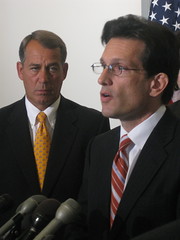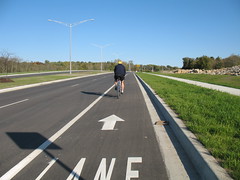Concern builds about possible opposition to bicycle & pedestrian funding in the federal transportation budget
Yesterday we reported that the U.S. House is preparing the to introduce large cuts to the proposed federal budget and an attempt could be made to dramatically cut or even eliminate funding for bicycle and pedestrian transportation in the federal budget.
Why the concern?
 The short answer is that some members of Congress have declared that cutting these programs is among their priorities--and after the recent elections, some of those members are now in key leadership positions.
The short answer is that some members of Congress have declared that cutting these programs is among their priorities--and after the recent elections, some of those members are now in key leadership positions.
Proposals by Eric Cantor, House Majority Leader
Eric Cantor, now House Majority Leader, has been particularly vocal in demanding cuts in bicycle and pedestrian related programs. A budget proposal posted at ericcantor.com includes these paragraphs:
Terminate Safe Routes to Schools Program (Saves $915 Million over five years)The Federal “Safe Routes to Schools Program,” started in 2005, finances infrastructure and non- infrastructure projects to assist children who walk or bike to school. This program fulfills what has traditionally been viewed as a local responsibility. Placing this task back in the hands of state and local officials would save $183 million a year or $915 million over five years.
Terminate Federal Transportation Funding For “Non-Motorized” TransportationProjects (Saves $125 Million over 5 years)Taxpayers are currently spending $25 million on four “Non- motorized Transportation Pilot” programs designed to encourage residents to walk or bike instead of taking a car. Federal resources should be focused on transportation projects with legitimate federal connections. Terminating this program saves taxpayers $125 million over five years.Eliminate Federal Transportation Funding for Landscaping, Museums, And OtherTransportation “Enhancements” (Saves $4.1 billion over 5 years)The Federal government spends most transportation fund on interstate highways and mass transit. However, $833 million is allocated to “transportation enhancement” projects including establishment of transportation museums, historic preservation, and pedestrian and bike facilities. Putting these “enhancement” projects back in the hands of state and local governments by terminating federal funding saves taxpayers $4.1 billion over five years.
Terminate the House of Representative Wheels for Wellness Bike Sharing Program(Indeterminate)The Chief Administrative Officer introduced a program that leases 30 bikes, at the taxpayer’s expense, for free use by all House staff during the workday for purposes of exercise and running errands. In the year that the program has operated, the bikes have been checked out less than 300 times, totaling about $73 per ride, as the full cost of leasing the bikes was $22,000. The Wheels for Wellness Program should be terminated so that the savings can be used for deficit reduction.

Cantor also said Republicans would focus on spending, ending the automatic federal pay raise and the building of bike paths, which he considers "nice, but certainly shouldn't be the priority."
[T]he grassroots enthusiasm surrounding the proposal was overwhelmingly in favor of cutting the funds spent on duplicative programs (bike paths in this instance) to save taxpayer dollars . . . The proposal to cut taxpayer funding for duplicative bike paths did not receive the most votes this week (a proposal to sell excess federal lands did), but it still generated a groundswell of public support and will certainly be considered in future YouCut votes.
There are a handful of Members of Congress who still want to strip every funding program for bikes out of the budget – this time Congressman Broun ofGeorgia tried to introduce an amendment to prevent ANY funds in the bill going to bike paths; that proposal wasn’t even considered in bounds, so we didn’t have to go through the fire drill of getting folks wound up to defend bike funding. (Don’t worry, though, it seems inevitable it will come up again…!)
- 2009: Two senate amendments to eliminate or reduce funding, spearheaded by Senators Coburn and McCain. Result: One withdrawn, one defeated.
- 2005: A surprise attack on Enhancements funding was launched by Senator Sessions--a floor amendment to eliminate Enhancements funding. Result: Defeated 84-16.
- 2003: House Appropriations Committee eliminated Transportation Enhancements. Result: Funding was restored on a floor vote, 327-90.

- Contact your members of Congress and let them know you support bicycle and pedestrian funding. Look up your Congressional representatives here.
- Look up the list of Transportation Enhancements projects in Missouri (available sorted by county, Congressional District, etc) and share some of the best in their district with your elected leaders.
- If and when an attack on bicycle and pedestrian funding is launched in Congress this year, we will issue advocacy alerts with detailed instructions. Join our Advocacy Network and stay tuned for alerts in the months and weeks ahead.
- Advocacy Alerts
- News
- Safe Routes to School
- Tour of Missouri
- 2003
- 2005
- 2009
- 2010
- 2011
- 2013
- 501c3
- about
- accomplishments
- active lifestyle
- adt
- advocacy
- america
- appropriations committee
- bicycle
- bicycle routes
- bicycling
- bicyclists
- Bike
- bike sharing
- bikeleague
- bill
- blog
- budget
- business
- children
- community
- congress
- cost
- document
- elections
- Eric Cantor
- exercise
- federal funding
- federal transportation
- fire
- form
- funding
- health
- house
- infrastructure
- istea
- join
- league of american bicyclists
- legislative
- links
- livability
- liveability
- meeting
- members
- missouri
- missouri bicycle federation
- Missouri Tourism
- mobikefed
- opposition
- parks
- pedestrian
- photos
- planning
- policy
- politics
- recreation
- resource
- resources
- ride
- roads
- routes
- rules
- running
- safe-routes-to-school
- savings
- school
- schools
- senate
- sidewalks
- story
- transit
- transportation
- transportation enhancements
- transportation funding
- used
- vacation
- vote
- walking
- Washington
- Andy Clarke
- Bicycle
- Bicycle sharing system
- Business
- Chicagoland Bicycle Federation
- Coburn
- Congress
- Cycling
- Eric Cantor
- Georgia
- Human behavior
- League of American Bicyclists
- McCain
- Motion
- Paul Broun
- Pedestrian
- Personal life
- Recreation
- Senate
- Sustainability
- Sustainable transport
- Technology
- Transport
- transportation
Join MoBikeFed's Advocacy Network
Working together we make a real difference! Join our advocacy network:
Related pages
Current topics...
Archives...
Want better bicycling and walking in Missouri?
We rely on the support of members like you. Please join, renew, or donate today.
- Home
- JOIN/DONATE
- News/Info
- Missouri Bicycling, Running, Trails
- Bicycle Skills and Safety
- Missouri Bike/Ped Law
- Clubs and Organizations
- Bike Shops
- Running Shops
- Bicycling, Running, Trails-related Businesses
- Ride, Run, Walk, Hike, Triathlon, and Events Calendars
- Bicycles on Amtrak
- Maps and Routes
- Trails and Trail Maps
- IBikeMO.org
- Planning a Missouri bicycle trip
- Gravel and Bikepacking Maps & Routes
- Bicycle & Touring Routes
- Advocacy
- Campaigns
- Our Legislative Platform
- Complete Streets
- Statewide Rock Island Trail
- Statewide Trail Vision - Quad State Trail
- Bicycle Friendly Missouri
- Walk Friendly Missouri
- Safe Routes to School
- MoDOT funding crisis
- High Priority Bike/Ped Project List
- Anti-harassment laws in cities & statewide
- Updating the basic bicycle law
- Our Vision for MoDOT
- Our Vision for MPOs/RPCs
- Our Vision for Cities & Counties
- Bicycle, pedestrian, trails plans across MO
- Protecting Vulnerable Road Users
- Vision Zero
- Missouri Trail Towns
- Store
- About

